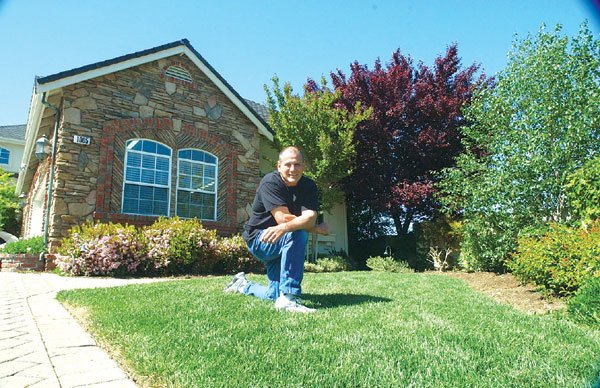When Steve and Dale Cunningham bought their Morgan Hill home
five years ago, the front yard was literally a blank slate.
About two thirds of the space was nothing but dirt, but the
Cunninghams had a vision for a lush and grassy oasis despite the
fact that their home was right next to a busy street.
When Steve and Dale Cunningham bought their Morgan Hill home five years ago, the front yard was literally a blank slate.
About two thirds of the space was nothing but dirt, but the Cunninghams had a vision for a lush and grassy oasis despite the fact that their home was right next to a busy street.
They created the space of their dreams, complete with pond, gazebo and arbor in the back yard and eye-pleasing greens in the front by investing 10 percent of their home’s value into landscaping.
It’s a standard figure for the area, said Steve, a real estate agent with Alain Pinel in Morgan Hill. He has since been approached by people wanting to hold everything from birthday parties to weddings on what neighbors say used to be a percolation pond.
In the competitive and costly South Valley housing market, first impressions count.
If you’re considering selling your home, or you’re receiving complaints from the neighbors, invest in the chance to make a good first impression with just a few changes to your home’s exterior
Even a small investment can go a long way in sprucing up a second-rate landscape, giving prospective buyers a positive feeling before they ever set foot inside your door.
In some cases, it can actually add dollars to a home’s bottom line when sales time rolls around.
And until then, the additional greenery can give homeowners years of enjoyment before they ever consider parting with their beautiful home, according to Don Jensen, owner of Don Jensen Landscape Architects in Morgan Hill.
Jensen suggests making a statement, even if your starting point is an average suburban landscape – tiny yard, overshadowed entryway and gargantuan, interest-sucking garage doors included.
“With larger houses and smaller lots, most of the home’s space is in the front yard, so creating usable space in the front yard is important,” said Jensen. “For that, the courtyard is the way to go. A nice seating area or a fountain is water-conserving because you minimize the lawn, and it also helps to identify the front door. It needs to be a bit more of a formal area because the entry says everything about the house. It carries your first impression.”
The first order of business, assuming the homeowner has a typical yard with grass and a few shrubs, is to rip out the concrete walkway that leads to the front door, said Jensen.
Instead, he suggests looking for a material – anything from flagstone or slate to tile – that will maintain the continuity of your home’s style, color or décor.
For instance, if a home has brick in a portion of its exterior design, Jensen will suggest a brick walkway.
“What most houses have is usually a three to four foot wide concrete path, and that is put in because it’s required by code and it’s the least expensive thing for the builder,” said Jensen, who suggests homeowners install a five- to six-foot-wide walkway so that two people may walk abreast of one another on the way up to the door. “The entry paving material has to be the best, most expensive thing in the yard because, remember, it’s the most formal piece. It’s the first impression of the yard, which is the first impression of the house.”
It all sounds like good advice to Karen Aitken, a landscape architect herself and owner of Red Roof Garden Company, formerly All Points Landscaping.
The walkway is the one major item Aitken would suggest a homeowner on a limited budget change in front of his or her home, either by ripping it out entirely or by putting down a color stain or faux finish that imitates stone.
Other, less expensive projects Aitken would suggest include, new paint for the home as well as the addition of flowers.
“You can never have too many flowers,” said Aitken, who suggested adding pottery and potted annuals to a porch or walkway area as a way of creating additional interest in the space.
For a home with a porch, clearing excess junk and setting out a comfortable arrangement of furniture, such as a pair of wicker chairs or a bench with some cushions, can also create an inviting space with minimal fiscal impact.
And rather than undergoing major renovations to a shrinking violet of a doorway, Aitken suggests painting the door itself, preferably in an eye-catching blue or red.













![‘[title of show]’: A musical about writing a musical](https://gilroydispatch.com/wp-content/uploads/sites/17/2011/06/http3A2F2Fgilroydispatch.blvds_.com2Fassets2F1a29cb0b11a08205bc98aac09945c47c-100x70.jpg)